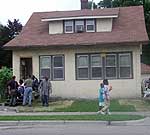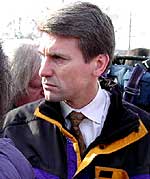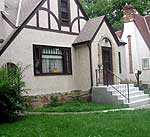By Brandt Williams
Minnesota Public Radio
August 23, 2002
Minneapolis officials and leaders of a north Minneapolis neighborhood urged peace and calm Friday, following an incident Thursday night that resulted in one wounded boy and assaults on several reporters. What began as a drug raid escalated into a riot, when a bullet fired by an officer at a pit bull dog either ricocheted or dislodged concrete that hit the boy in the forearm. People upset by the injury to the boy yelled at police and hurled rocks and bottles. They also took out their anger on several news reporters and their vehicles by setting one on fire and breaking out windows in others.
| |
|
|
|
||
The morning after the riot, Minneapolis Mayor R.T. Rybak was called into an impromptu meeting at the Urban League to meet with Police Chief Robert Olson, community activist Spike Moss and other community leaders. Rybak says the meeting was held to talk about how to cool off a smoldering situation.
"We're at a period of tension where a single incident can be seen as something larger. That's why it's especially important for all parts of the community to come together and to make sure that we can calm tempers right now," said Rybak.
Tempers flared Thursday night after police raided a house at the corner of 26th and Knox Ave. North, looking for drugs and guns. The shooting occurred on the sidewalk in front of the house, as police say they were shooting at a pit bull they believe was turned on them by its owner. The dog was killed and 11-year-old Julius Powell was hit in the arm.
A crowd gathered as police blocked the area with yellow tape. Soon they were joined by a number of reporters and TV photographers. The crowd became boisterous and restless, and Chief Robert Olson says that's when precinct commanders decided to pull officers out of the area.
| |
|
|
|
||
"We pulled out of there a couple of times. Part of the equation of making things calm is to make sure you don't do anything - even inadvertantly - to excerbate things," he said.
Olson says officers never left the area entirely. However, rioters took advantage of the situation and went on a rampage. Nearly an hour later, about 20 police officers came back to the intersection to clear the area.
The riot came at a time when tensions were already running high in north Minneapolis. Two weeks ago, a young African American male alleged to be carrying a gun was shot by white police officers. An angry, predominantly black crowd gathered and accused the police of targeting African Americans.
Activist Spike Moss was at the site of the shooting two weeks ago, and was called in to help calm down Thursday night's riot. Moss has been criticized by some for increasing the racial tension - especially when a black person has been shot by a white officer. But he says African Americans should be angry whenever violence is committed against a black person, regardless of the race of the perpetrator.
| |
|
|
|
||
"This ain't a race issue, that one person can shoot me and another person can't. You can't shoot me. You can't assault me. You can't even stab me. I don't even need you hittin' me in the head," said Moss. "And when we get crazy enough, brothers, to say that my lump is alright, as long as a brother put it there, then we've lost our minds."
Moss says the black community must play a role in appealing for calm. But it will be hard to sooth the anger of some.
"They straight up came out shooting the dog and hitting my cousin. I don't like that s**t, man," said Toney Powell, who is staying temporarily at the house where the police raid took place.
Powell says he and his pregnant wife were handcuffed and roughly forced to lay on the sidewalk, but were not arrested. His cousin Shirley Powell, who lives at the house, was arrested on a weapons charge. Another man was arrested for a narcotics charge and another woman at the house was also arrested on a weapons charge.
Police and neighbors say the house is a known drug spot, but Powell says that's not true. He says they try to keep drug dealers away from there.
"Kids - they be here every day. That's why we try to keep the drug dealers away," Powell said. "We've got too many cousins and nephews and stuff that come over to visit my cousin. So why would we want to have drugs and stuff around here?"
The Powell family rents the house from an owner who lives in Elk River, and neighbors say they've tried to contact the man to tell him about what goes on at the house. Police records show that in the last five years there have been 63 incidents reported at the address, including a shooting earlier this year.
While community leaders continue to call for peace and healing - some people who were caught up in the riot will need some healing of another sort.
"My knees got pretty scraped up. There's tissue damage to my nose, there's a bone in my right elbow that was broken," says David Chanen, a crime reporter for the Star Tribune newspaper. He is one of several media members who were assaulted.
"Lots of bumps and bruises on my head, and by my kidney there's a laceration about the size of a softball where they were just kicking me in the back in my kidneys. But fortunately I didn't have any kidney damage or anything," he said.
Chanen says he was jumped by several young men while trying to leave the scene. While he was being assaulted, his colleague and fellow crime reporter Howie Padilla told the men to stop beating Chanen because he was a reporter. He says the men stopped beating him and then went after Padilla. Padilla suffered a several broken teeth, a broken nose and maybe a broken jaw.
Chanen says he's been in hostile situations before, but never one that threatened his personal safety.
"I don't know what it was about this," said Chanen. "I've been covering police for five years and I've never once felt that I needed to get away from the scene. I've never once had a hand laid on me."
Chanen, who is white, says he doesn't want to speculate as to why the group of young black men attacked him.
"Oh God, we come with the word of peace Lord. We come Lord, sowing your good seed, Lord."
Near the corner of 26th and Knox Ave., the quest for healing has begun. A group from Zion Baptist Church prayed and sang for peace Friday morning. They stood on the sidewalk next to a community garden which sits right next to 1716 26th, the site of the shooting.
The group has attracted the attention of neighborhood resident and community activist Greta Johnson. Johnson was outside during the riot, and says she got roughed up by some of the rioters. She's not impressed by the group that came here to make peace.
"I'm part of a community group that's been out here for over a year protesting these drug dealers," Johnson said. "I've never see you out here - never. We've asked for help - from the community, from the churches. We're putting our lives on the line standing out here on the corner and I've never seen you."
Pastor Curtis Herron appears not to be taken aback by Johnson's comments, and he praises her for her service to the community. Herron says his church has not been active until lately, but says he wants to work with Johnson and her neighbors.
"We need a connection with you so we can know what is going on, and know how we make some decisions - how we can relate to this situation," Herron said.
Johnson says she welcomes the church's help, but with a major qualification. She says she's tired of the racialization of conflicts between white police officers and black suspects.
Johnson, who is part African American, white and Native American, says she and some of her neighbors are wary of community leaders - like Spike Moss - who don't live in her neighborhood who claim to speak for the community.
"The people who are getting the sound bites are the people who are stirring up the people, who made this thing happen last night. It turned into a race issue and it was about drugs," said Johnson.
Spike Moss and other members of black men's groups are planning to patrol 26th St. to help police keep the peace in the neighborhood.
More from MPR


